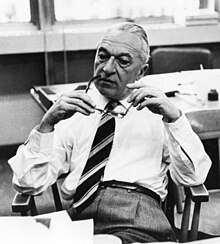Bruno Rossi
| Bruno Benedetto Rossi | |
|---|---|
 |
|
| Born |
13 April 1905 Venice, Italy |
| Died | 21 November 1993 (aged 88) Cambridge, Massachusetts, United States |
| Citizenship | Italian, American (after 1943) |
| Nationality | Italian |
| Institutions |
University of Florence University of Padua University of Manchester University of Chicago Cornell University Massachusetts Institute of Technology |
| Alma mater | University of Bologna |
| Doctoral advisor | Quirino Majorana |
| Doctoral students |
Giuseppe Occhialini Ettore Pancini Kenneth Greisen Matthew Sands Robert Hulsizer Bernard Gregory Herbert S. Bridge Martin Annis George W. Clark Stanislaw Olbert Yash Pal |
| Notable awards |
Elliott Cresson Medal (1974) National Medal of Science (1983) Wolf Prize in Physics (1987) Matteucci Medal (1991) |
| Spouse | Nora Lombroso |
| Signature | |
Bruno Benedetto Rossi (13 April 1905 – 21 November 1993) was an Italian experimental physicist. He made major contributions to particle physics and the study of cosmic rays. A 1927 graduate of the University of Bologna, he became interested in cosmic rays. To study them, he invented an improved electronic coincidence circuit, and travelled to Eritrea to conduct experiments that showed that cosmic ray intensity from the West was significantly larger than that from the East.
Forced to emigrate in October 1938 because of the Italian Racial Laws, Rossi moved to Denmark, where he worked with Niels Bohr, then to Britain, where he worked with Patrick Blackett at the University of Manchester, and finally to the United States, where he worked with Enrico Fermi at the University of Chicago, and later at Cornell University. Rossi stayed in the United States, and became an American Citizen.
During World War II, Rossi worked on radar at the MIT Radiation Laboratory, and he played a pivotal role in the Manhattan Project, heading the group at the Los Alamos Laboratory that carried out the RaLa Experiments. After the war, he was recruited by Jerrold Zacharias at MIT, where Rossi continued his pre-war research into cosmic rays.
In the 1960s, he pioneered X-ray astronomy and space plasma physics. His instrumentation on Explorer 10 detected the magnetopause, and he initiated the rocket experiments that discovered Scorpius X-1, the first extra-solar source of X-rays.
...
Wikipedia
